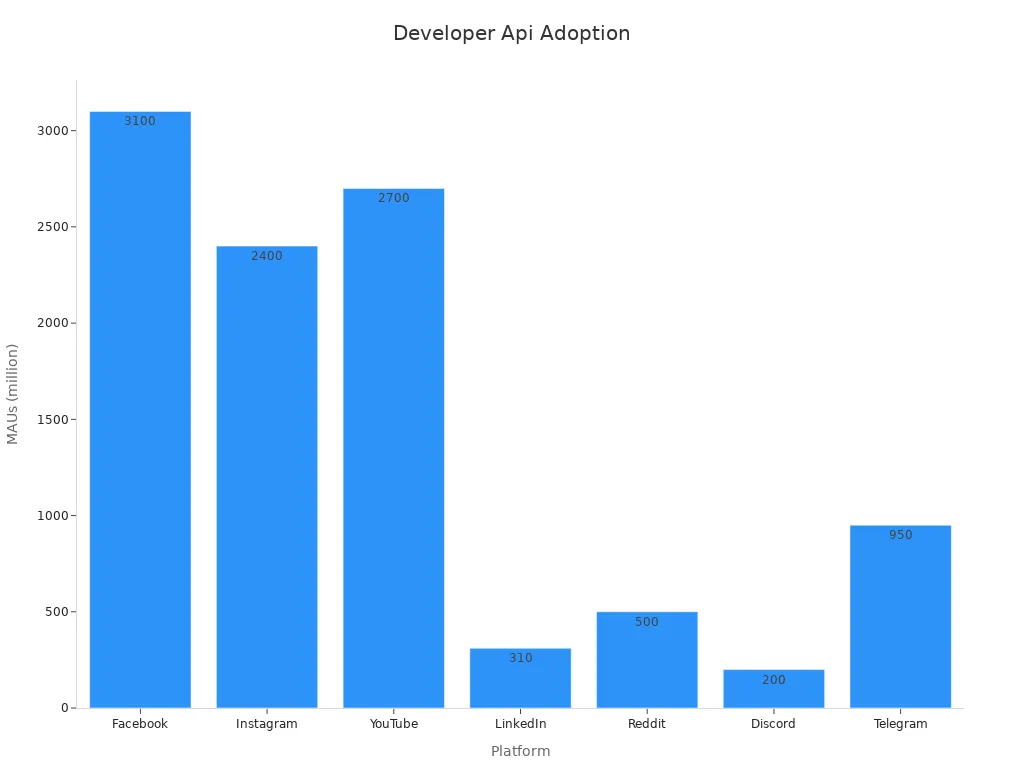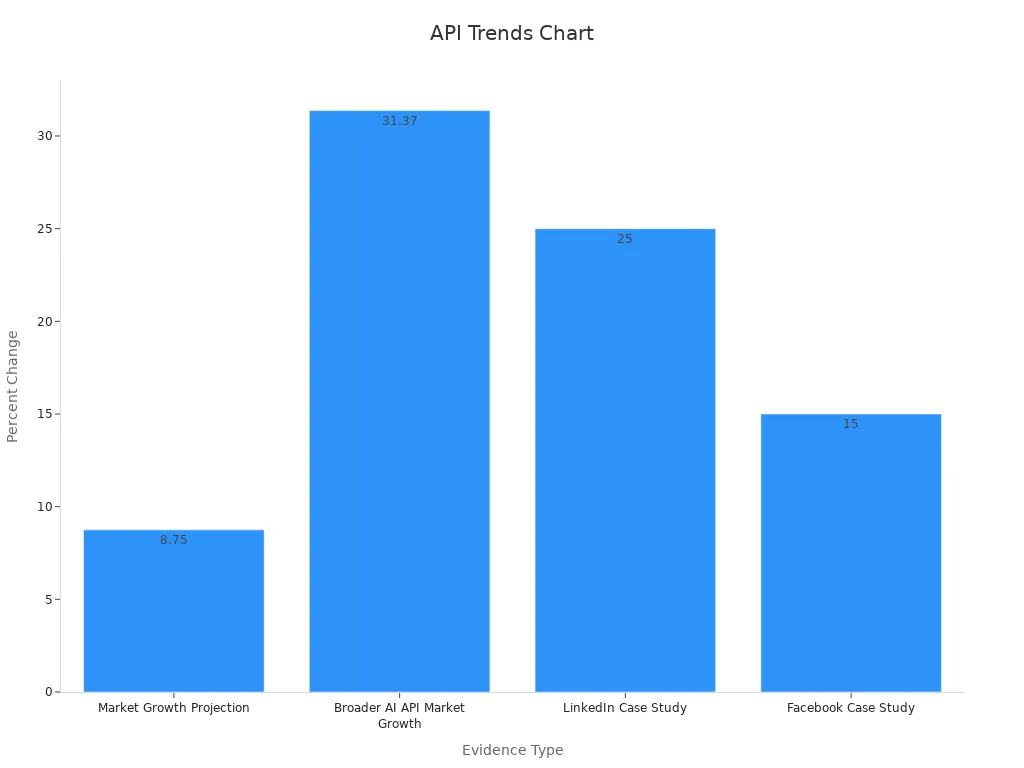Social media api

Here are the top 10 social media APIs you should know in 2025: Facebook, Instagram, LinkedIn, Medium, Pinterest, Reddit, Discord, Telegram, TikTok, and YouTube. You need these APIs to boost user engagement, automate tasks, and track analytics. Take a look at these trends shaping your work:
Trend Category | Numerical Evidence | Implication for Developer Engagement in 2025 |
|---|---|---|
AI App Market | $1.8B revenue in 2023; projected $18.8B by 2028; 230M users in 2024 | Demand for AI integration with social media api is soaring |
IoT Devices | Over 75B connected devices forecasted by 2025 | APIs must support more IoT data and connectivity |
Video Content Usage | 79% of U.S. users aged 18-34 watch online video weekly | Video and live streaming APIs are more important than ever |
You will find that sharing images or videos, managing analytics, and handling comments all need direct API integration. Social media api options keep growing, so you have more opportunities than ever.
Key Takeaways
Top social media APIs like Facebook, Instagram, LinkedIn, TikTok, and YouTube offer unique features to boost user engagement and automate tasks.
Using these APIs helps developers manage content, track analytics, and connect with large audiences across different platforms.
Proper setup, authentication, and rate limit management are essential to keep your app secure and running smoothly.
Staying updated on API changes and following security and compliance rules protects your app and user data.
Leveraging social media APIs can increase app visibility, improve user retention, and provide valuable insights for growth.
Top APIs

Facebook API
Facebook remains the largest social platform in 2025, with over 3.1 billion monthly active users. You can use the Facebook API to build apps that connect with groups, manage pages, and tap into Meta AI features. The API lets you automate posts, analyze engagement, and even sell products through Marketplace or live selling.
Tip: The approval process for Facebook API can be tricky. You need to submit your app for review before you get full access. This step helps protect user data and keeps the platform secure.
Key Features:
Access to Meta AI for smarter content suggestions.
Integration with Facebook Groups and Marketplace.
Real-time analytics and insights.
Developer Considerations:
The API approval process is complex.
You must follow strict data privacy rules.
Many developers use GraphQL for faster, more flexible queries.
Instagram API
Instagram is huge with Gen Z and Millennials, reaching 2.4 billion users. The Instagram API helps you manage posts, stories, and Reels. You can also use it to connect with Threads and Shop 2.0, making it a top choice for e-commerce projects.
Main Features:
Schedule and publish photos, videos, and Reels.
Analyze engagement and reach.
Integrate with Instagram Shop for direct sales.
Unique Points:
Instagram is part of the Meta ecosystem, so you need to go through a similar app approval process as Facebook.
AI-powered features help you create and manage content more easily.
LinkedIn API
LinkedIn is the go-to platform for professionals and B2B networking. With 310 million monthly users, the LinkedIn API lets you build tools for job searches, networking, and learning. You can use it to post updates, manage company pages, and access LinkedIn Learning content.
Main Functions:
Share professional updates and articles.
Access job postings and applicant data.
Use AI tools for content creation and analytics.
Developer Insights:
LinkedIn’s API is popular with business-focused developers.
You need to follow strict guidelines to protect user privacy.
Medium API
Medium is a favorite for long-form content and blogging. The Medium API lets you publish articles, manage drafts, and track engagement. You can use it to automate content posting or build tools for writers.
Platform Overview:
Publish and edit stories programmatically.
Access user stats and engagement data.
Integrate with other writing tools.
Considerations:
Medium appeals to niche and content-focused developers.
The API is simple but powerful for content automation.
Pinterest API
Pinterest helps users discover and save ideas. The Pinterest API lets you create, manage, and analyze Pins and boards. You can use it to build apps for e-commerce, inspiration, or trend tracking.
Main Features:
Create and organize Pins and boards.
Access analytics on Pin performance.
Integrate with shopping tools.
Unique Points:
Pinterest is popular for visual content and shopping.
The API is great for brands and creators who want to reach new audiences.
Reddit API
Reddit is all about communities and discussions. With 500 million users, the Reddit API lets you access posts, comments, and user data from thousands of subreddits. You can use it to build bots, analyze trends, or manage content.
Key Functions:
Fetch and post comments or threads.
Analyze community engagement.
Automate moderation tasks.
Developer Considerations:
Reddit’s API is open but has strict rate limits.
Appeals to developers interested in niche communities.
Discord API
Discord is a top choice for private servers and real-time chat. The Discord API lets you build bots, manage servers, and create custom integrations for voice, video, and text chat.
Main Features:
Build bots for moderation, games, or notifications.
Manage server roles and permissions.
Integrate with other apps for seamless communication.
Unique Points:
Discord is popular for community engagement and niche marketing.
The API is bot-focused and easy to register.
Telegram API
Telegram is known for privacy and fast messaging. The Telegram API lets you build bots, manage channels, and automate messages. You can use it to create custom chat experiences or broadcast updates to large audiences.
Platform Overview:
Create and manage bots for automation.
Send messages to channels and groups.
Focus on privacy and security.
Developer Insights:
Telegram’s API is easy to use and supports unique bot authorization.
Growing interest among developers for secure messaging solutions.
TikTok API
TikTok is the leader in short-form video. The TikTok API lets you publish videos, manage user profiles, and track engagement. You can use it to create viral campaigns or analyze trends.
Main Functions:
Upload and manage short videos.
Access analytics on video performance.
Integrate with direct publishing tools.
Unique Points:
TikTok’s API can be hard to integrate due to documentation issues.
The platform is growing fast, especially with younger users.
YouTube API
YouTube is the top video platform, with 2.7 billion users. The YouTube API lets you upload videos, manage playlists, and access analytics. You can use it to build content management tools or automate video publishing.
Key Features:
Upload and organize videos and playlists.
Access detailed analytics and monetization tools.
Integrate with shopping and live streaming features.
Developer Considerations:
YouTube’s API is well-documented and widely used.
Great for developers focused on video content and monetization.
Did you know?
Most digital businesses now use third-party APIs like these to build new products and automate workflows. The API-first approach is standard in 2025, making it easier for you to scale and collaborate.
API Adoption by Platform

The number of API endpoints has nearly doubled in the past year.
Over 55% of organizations faced API-related security events in 2024.
Blockchain-enabled APIs are on the rise, improving security and opening new ways to monetize your apps.
AI now helps automate API documentation and boost performance, making your development process smoother.
You can see that each social media api offers unique features and challenges. Choosing the right one depends on your project goals, target audience, and the type of content you want to manage or share.
Features
Platform Overview
You use social media APIs to connect your apps with the world’s biggest platforms. Each one gives you special access to features that match the platform’s style. For example, Facebook lets you tap into huge user groups and detailed engagement data. Instagram focuses on photos, videos, and influencer stats. LinkedIn stands out for professional networking and job tools. YouTube and TikTok both center on video, but each has its own vibe and audience.
When you pick a social media api, think about what makes each platform unique. Some focus on visuals, others on text or professional content. This helps you reach the right users and create the best experience.
Main Functions
Most social media APIs help you do a few key things:
Share and schedule posts, photos, or videos.
Get analytics on likes, comments, and shares.
Manage user profiles, pages, or channels.
Automate replies or moderation.
Connect with shopping, live events, or influencer tools.
You can also use these APIs to build bots, track trends, or even run contests. Each platform offers different tools, so you can pick what fits your project best.
Unique Points
Every platform brings something special to the table. Here’s a quick look at what sets them apart in 2025:
Platform | Unique API Features and Focus Areas | Distinguishing Points in 2025 |
|---|---|---|
Broad access to user profiles, posts, comments, likes, shares | Extensive user engagement data enabling wide social insights | |
Visual content access, influencer metrics | Focus on images, videos, and influencer marketing analytics | |
Professional profiles, company pages, job postings | B2B data and recruitment-focused API | |
YouTube | Video metadata, comments, channel info | Largest video platform data for content research |
TikTok | Video content, user profiles, engagement metrics | Captures trends and Gen Z behavior through short-form videos |
You see platforms using social proof, hosting webinars, and offering free trials to attract developers. They also keep APIs fresh by listening to feedback and rolling out updates. If you tailor your content to each platform’s style—like short videos for TikTok or professional posts for LinkedIn—you boost engagement and make your app stand out.
Integration
Setup
Getting started with social media APIs in 2025 feels easier than ever, but you still need to follow some clear steps. Most platforms want you to sign up for a developer account and access their dashboard. You usually create a connector or app, enter your project details, and get a unique ID. Some platforms, like Bindbee, let you generate a magic link for quick authentication. After you connect, you can sync data and monitor the status right from the dashboard. Once everything is set, you receive an API key and a connector token. These let you make secure requests to the platform.
Here’s a typical setup process:
Create a connector or app, entering your project details.
Generate a magic link or similar tool to authenticate your connection.
Sync your connector to start data flow.
Access your synced data through the dashboard.
Get your API key and connector token for secure requests.
Tip: Always double-check your API keys and tokens. Keep them private to protect your app and users.
Authentication
You need to authenticate your app before you can use most social media APIs. This process can feel tricky, but it keeps your data safe. First, register your app to get your client credentials, like a Client ID and Client Secret. Next, users give permission by logging in through the platform’s authorization server. Your app then gets an authorization code, which you swap for an access token. You use this token to make secure API calls.
Many developers say authentication takes time and adds extra steps. You must manage your tokens carefully and update them often to avoid security problems. Some platforms use special protocols, like JWT, or require you to create sessions and store tokens. If you skip a step, you might get locked out or face errors.
Rate Limits
Every social media API sets limits on how many requests you can make. These rate limits help keep the platform stable and fair for everyone. If you go over the limit, you might see errors like “429: Rate limit exceeded.” Most APIs use pagination tools, such as offset, limit, or cursor, to help you manage large data sets without hitting these limits.
You should always check the documentation for each platform’s rules. If you plan to sync lots of data or run frequent updates, spread out your requests. Watch for status codes like 200 (OK), 401 (Unauthorized), or 429 (Rate limit exceeded) to spot problems early.
Note: Smart rate limit management keeps your app running smoothly and helps you avoid temporary bans or service interruptions.
Social Media API Comparison

Documentation
When you start working with a social media api, you want clear and easy-to-follow documentation. Good docs help you set up your app, understand endpoints, and troubleshoot problems. Some platforms give you step-by-step guides, code samples, and even video tutorials. Others might only offer basic reference pages. You should always check if the docs get regular updates and if they cover new features. Platforms like YouTube and Discord often update their docs quickly when they launch something new. This makes your job much easier and helps you avoid mistakes.
Tip: Look for platforms that offer interactive API explorers or sandboxes. These tools let you test requests before you add them to your code.
Support
You want fast and helpful support when you run into issues. Some platforms offer live chat, email, or even phone support. Others rely on ticket systems or community forums. Here’s a quick look at how some popular platforms handle support:
API/Platform | |
|---|---|
30 minutes during business hours | |
Amazon | 24-hour email response time |
Salesforce | Sub-2-hour response for priority customers |
Buffer | 1-hour response to social media inquiries |
You can also find ratings for support tools. JivoChat scores 4.6 out of 5 on G2, with over 1,200 reviews. HelpCrunch gets a 4.7 out of 5, and Userlike has a 4.4 rating. These tools use AI chatbots and track customer satisfaction, so you get faster answers and better help.
Community
A strong developer community makes your experience smoother. You get answers, share tips, and learn from others. Many platforms use AI-driven tools like Disco AI to keep conversations lively. You can join real-time chats, attend live events, or answer polls and questions. Gamification features like leaderboards and badges motivate you to join in.
You see regular live events and webinars for real-time help.
User-generated content and updated features keep things fresh.
Moderation tools and inclusive spaces make everyone feel welcome.
Analytics track post activity, event attendance, and engagement.
Metric Type | Description |
|---|---|
Active Followers | Users who regularly engage with content, showing ongoing interest. |
Thoughtful Comments | Comments that show real interest, not just quick reactions. |
Returning Users | People who come back often, showing strong involvement. |
Audience Engagement Over Time | Members who stay active for a long time, building lasting relationships. |
When you join a platform with a vibrant community, you get more support and better ideas for your projects.
Benefits
Engagement
You want your users to stick around and interact with your app. Social media APIs help you do just that. They let you personalize content, add fun challenges, and show users what matters most to them. For example, you can use APIs to recommend posts, create leaderboards, or send special badges. These features keep people coming back.
A recent study shows that viral posts only give you a quick boost in attention. The excitement fades fast. If you want real, lasting engagement, you need to focus on steady, personal connections. APIs make it easy to build these connections by letting you tailor the experience for each user.
Metric | Description |
|---|---|
Time spent | How long users stay on your app |
Interactions | Likes, comments, shares, and other actions |
Retention | How many users return over time |
Bounce rate | Users who leave without doing anything |
Engagement rate | Users who actively interact |
You can use these metrics to see what works and keep improving your app.
Automation
APIs save you time by handling tasks for you. You can schedule posts, reply to comments, or even run contests without lifting a finger. Automation lets you focus on big ideas while your app takes care of the details. Imagine setting up a bot that welcomes new users or sends reminders about events. You can also use automation to keep your content fresh, even when you are busy.
Tip: Automation helps you stay active on social media, even when you are not online. This keeps your audience engaged and your brand top of mind.
Analytics
You need to know what works and what does not. APIs give you powerful tools to track your progress. You can see how many people click your links, what they say about your brand, and how your posts lead to real results.
Click-Through Rate (CTR): Shows how many users take action.
Sentiment Analysis: Tells you if people feel good or bad about your brand.
Conversion Metrics: Tracks leads, sales, and customer costs.
Real-Time Reporting: Gives you instant updates for quick changes.
Integration: Lets you see data from all your social channels in one place.
Historical Comparison: Helps you spot trends and improve over time.
With these insights, you can make smarter choices and grow your business.
Best Practices
Updates
You need to stay on top of API updates if you want your app to work well. Platforms change their APIs all the time. Sometimes, they add new features. Other times, they change how you get data or even remove old tools. If you miss an update, your app might stop working or lose important information.
The API management market is growing fast. Experts say it will jump from $7.16 billion in 2024 to $9.70 billion in 2025.
Platforms like X (formerly Twitter) often update their APIs. These changes help you capture posts and comments more accurately.
Real-time data sync and event-driven systems are now must-haves. They help you keep your data fresh and your users happy.
Tip: Set up alerts for API changes. Check the official docs often. This way, you never miss a big update.
Security
You handle a lot of sensitive data when you use social media APIs. Hackers look for weak spots. You do not want to be the next headline. Big companies like T-Mobile and Facebook have faced huge breaches because of API problems. In one case, a single API leak exposed 37 million accounts!
Here are some ways to keep your app safe:
Only give access to people who really need it.
Encrypt all your data, both when you send it and when you store it.
Use HTTPS with SSL/TLS for every API call.
Watch for strange activity and test your APIs often.
Manage your tokens in one place so you can revoke them fast if needed.
Remember: Most companies do not have a full API security plan. You can get ahead by making security a top priority.
Compliance
You must follow each platform’s rules. These rules change a lot, especially after big privacy scandals. For example, Twitter now lets you share only Tweet IDs, not the full content. This makes it harder for researchers to check data, but it protects user privacy.
Platforms update their terms to stop data leaks and protect users.
New rules can limit what data you can collect or share.
Removing personal info from your data is now a must, but it can make your job harder.
End User License Agreements (EULAs) can stop you from sharing data outside the platform.
Note: Always read the latest developer policies. If you break the rules, you could lose access or face legal trouble.
You can unlock big opportunities when you master these APIs. You build apps faster, save money, and join a creative developer community.
You boost app visibility, user engagement, and brand awareness.
You get real feedback and track key metrics like click-through and retention rates.
Evidence Type | Statistic/Impact |
|---|---|
Market Growth | |
Engagement Boost | LinkedIn saw 25% more engagement with data APIs |
Revenue Increase | Facebook ad revenue jumped 15% after API improvements |

Stay curious. Explore docs, join developer groups, or start a new project. These platforms change fast, so keep learning and updating your skills.
FAQ
How do you choose the right social media API for your project?
You should look at your project goals and your target audience. Think about what kind of content you want to share. Check each API’s features and see which one matches your needs best.
Do you need to pay to use these APIs?
Most social media APIs offer free access for basic use. If you want advanced features or higher limits, you might need a paid plan. Always check the pricing page before you start.
What happens if you hit an API rate limit?
You might see errors or your app could stop working for a while. Most platforms tell you how many requests you can make. Spread out your requests and watch for warning messages.
Can you use more than one social media API in your app?
Yes! You can connect to several APIs at once. Many apps use Facebook, Instagram, and YouTube together. Just make sure you follow each platform’s rules and manage your API keys safely.
See Also
The Complete Handbook For TikTok Analytics Tools
